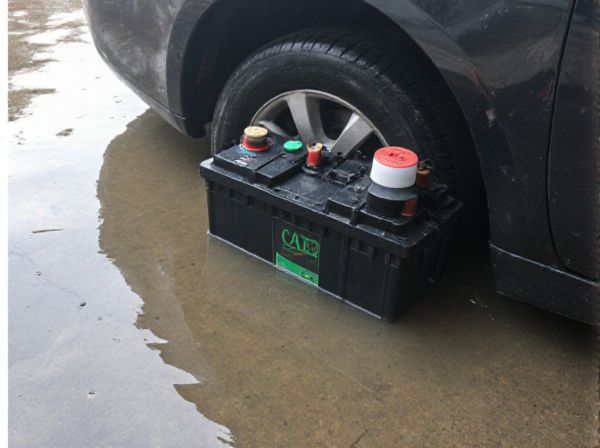
Photo illustration: Flooded vs Sealed
Flooded and sealed batteries differ in maintenance and performance; flooded batteries require regular water refilling and venting, while sealed batteries are maintenance-free and spill-proof. Your choice depends on usage conditions--flooded types are ideal for heavy-duty applications with high durability, whereas sealed batteries offer convenience and safety in confined or sensitive environments. Sealed batteries typically have lower risk of acid leakage and are better suited for portable or indoor use.
Table of Comparison
| Feature | Flooded Battery | Sealed Battery |
|---|---|---|
| Design | Wet cell with liquid electrolyte | Absorbed glass mat (AGM) or gel, sealed |
| Maintenance | Requires regular water topping | Maintenance-free, no water addition |
| Durability | Shorter lifespan, prone to spillage | Longer lifespan, spill-proof design |
| Performance | Good for high cranking power, slower recharge | Better deep cycle capability, faster recharge |
| Cost | Lower initial cost | Higher upfront cost |
| Safety | Releases gases, needs ventilation | Sealed, minimal gas emission |
| Weight | Heavier due to liquid electrolyte | Lighter and compact |
Introduction to Flooded and Sealed Batteries
Flooded batteries consist of lead-acid cells submerged in a liquid electrolyte, allowing for ease of maintenance and effective heat dissipation. Sealed batteries, also known as valve-regulated lead-acid (VRLA) batteries, are designed with a fixed electrolyte gel or absorbent glass mat (AGM) that prevents spillage and minimizes maintenance. These fundamental differences impact battery lifespan, safety, and application suitability in automotive and renewable energy systems.
Understanding Battery Construction
Flooded batteries feature liquid electrolyte that submerges the internal plates, allowing for effective heat dissipation and easier maintenance through water replenishment. Sealed batteries use absorbed glass mat (AGM) or gel electrolytes, preventing spills and reducing the risk of corrosion while offering enhanced vibration resistance and lower self-discharge rates. Choosing between flooded and sealed designs depends on specific application needs such as maintenance capacity, durability requirements, and operating environment.
Key Differences: Flooded vs Sealed Batteries
Flooded batteries contain liquid electrolyte that submerges the plates, allowing for easier maintenance such as water refilling, while sealed batteries use a dry or gel electrolyte, offering a spill-proof and maintenance-free design. Flooded batteries typically have a longer lifespan and handle deep discharges better, but require ventilation due to gas release during charging, unlike sealed batteries which provide safer indoor use. Cost differences are notable, with flooded batteries generally more affordable upfront and sealed batteries costing more for their convenience and compact design.
Lifespan and Durability Comparison
Flooded lead-acid batteries typically have a shorter lifespan, ranging from 3 to 5 years, as they require regular maintenance to prevent electrolyte evaporation and corrosion. Sealed lead-acid batteries, including AGM and gel types, offer enhanced durability with lifespans extending up to 7 years due to their maintenance-free design and better resistance to vibration and leakage. The sealed construction improves reliability in harsh conditions, making them suitable for applications demanding long-term, stable performance.
Maintenance Requirements
Flooded lead-acid batteries require regular maintenance including checking water levels, topping up with distilled water, and cleaning terminals to prevent corrosion. Sealed lead-acid batteries are maintenance-free, as they are designed to recombine gases internally and do not need water refilling. Proper maintenance of flooded batteries extends their lifespan, while sealed batteries offer convenience and reduced risk of acid leaks.
Performance in Various Applications
Flooded batteries deliver higher power output and longer runtime, making them ideal for heavy-duty applications like forklifts, golf carts, and industrial equipment. Sealed batteries, particularly AGM and gel types, offer superior maintenance-free performance with better resistance to vibration and temperature extremes, suited for automotive, marine, and backup power systems. Performance in various applications depends on factors like discharge rates, cycle life, and environmental conditions, where flooded batteries excel in deep cycling and sealed batteries provide enhanced durability and safety.
Safety Considerations and Risks
Flooded batteries typically require regular maintenance to monitor electrolyte levels, posing risks of acid spills and hydrogen gas buildup, which necessitate proper ventilation for safety. Sealed batteries, such as AGM or gel types, reduce the risk of leaks and off-gassing, offering safer installation in confined spaces but may be more sensitive to overcharging and high temperatures. Proper charging systems and temperature management are critical for both battery types to prevent hazards like thermal runaway, explosions, or damage.
Cost Analysis and Value
Flooded lead-acid batteries generally have a lower upfront cost compared to sealed AGM (Absorbent Glass Mat) batteries, making them a budget-friendly option for large-scale energy storage. Sealed batteries offer higher maintenance savings and longer lifespan, which can result in better long-term value despite a higher initial investment. When evaluating cost analysis, the balancing of initial price against durability, efficiency, and reduced maintenance costs determines the overall return on investment for each battery type.
Environmental Impact and Disposal
Flooded lead-acid batteries release hazardous sulfuric acid and heavy metals into the environment if improperly disposed, posing significant contamination risks to soil and water. Sealed lead-acid batteries, including Absorbent Glass Mat (AGM) and gel types, minimize leakage and reduce environmental hazards but still require specialized recycling processes to handle toxic components. Proper disposal and recycling of both types prevent toxic runoff and enable recovery of valuable materials like lead and plastic, reducing environmental impact.
Choosing the Right Battery for Your Needs
Flooded batteries offer a cost-effective solution with easy maintenance and reliable performance in stationary applications, making them ideal for solar energy storage and backup power systems. Sealed batteries, including AGM and gel types, provide spill-proof operation, vibration resistance, and low maintenance, suited for automotive, marine, and portable devices. Selecting the right battery depends on factors like budget, environment, maintenance capability, and specific energy demands to ensure optimal efficiency and lifespan.
 caratoz.com
caratoz.com